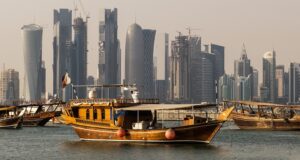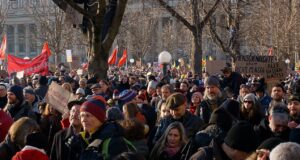6 April, 2021
By Mette Kaalby Vestergaard – Research Assistant
Newly signed peace agreements in central Mali
Since the outbreak of the war in Mali in 2012, tensions between ethnic groups have worsened and led to regular fighting between the different communities. This has resulted in instances of mass killings of civilians and an insecure environment for large parts of the population in the country.
On respectively the 12th, 22nd and 24th January 2021, three different peace agreements were signed by two of the local groups engaged in the fighting in central Mali since 2012 – namely the Fulani and Dogon communities. The negotiations have been led by the Centre for Humanitarian Dialogue (HD) community association and carried out at the local level. The agreements were signed by representatives from 11 different communities within the commune of Koro in central Mali, leaving 5 communities out of the agreement. While earlier efforts with agreements in 2018 have proved too fragile with the interference of surrounding armed groups, the attempt to established peace at a local level continues.
A history of conflict: Fulani and Dogon
The tensions between the two ethnic groups have been in existence for centuries. The populations nationally account for approximately 16% (Fulani) and 9% (Dogon) out of Mali’s around 20 million citizens. The conflicts are often caused by disagreements over land ownership between farmers. While the Fulani community is known as nomadic herders, the Dogon farmers and hunters are more geographically settled. The majority of the Dogon population adhere to traditional religions centering around the relationships in a spiritual world of ancestors, people, animals and plants. Meanwhile, the Fula people are predominantly Muslim, though with a very small minority who adhere to traditional African religions.
The Fulani militias have been operating in other Sahel countries such as Burkina Faso and Niger and is as such not only a community involved in central Mali, but throughout the Sahel region. They have several times been accused of working with Jihadist groups operating in the area – including both the Islamic State in West Africa Province (ISWAP) and al Qaeda in the Islamic Maghreb (AQIM).
The past years of conflict have involved ethnic killings, reportedly from both sides of the groups, and a pattern of continuous accusations can be seen. One of the larger examples are the attacks on Fulani villages in March 2019, killing more than 150 people. No one claimed responsibility, but as of today the Dogon people are still being blamed by the Fula people for carrying out the killings.
Content and focus of the agreement
As such, the conflict of concern is a long-term and deep-rooted one. When peace is negotiated at a national level, it can be very distanced from the expectations and needs that the local populations have. Negotiating peace at a local level, therefore, enables other focus points to be involved that might at a national level have seemed unimportant. The opportunities in negotiating peace at a local level, also lies in the greater degree of responsibility that the locals might feel in maintaining peace. Some of the elements reflecting these assets of this method, are seen in the content of the new agreements.
The peace agreements passed in January clearly reflects some of the motivations behind the conflict which are leading to violence. Some of the important points of the settlement – besides good will on establishing a pardoning and trustful relationship between the two – included the following:
- Opposing theft of livestock
- Facilitating the use of natural resources and land by all communities
- Avoiding the circulation of weapons in the villages and towns
Focusing on the root causes leading to violence will most often lead to a more sustainable peace than simply agreeing on halting violence. Moreover, the section included in the peace agreement named “Causes and consequences of conflict” illustrates very well this good precondition for peace. In this section the parties settle on the causes and as such underlines which consequences that would lead to violent action once again.
Opportunities and limitations
In an interview from 2019, the leader of the Dogon community expressed that the government security forces do not have the capacity nor the will to protect his people against the Fulani militias and other armed groups. Especially in these cases, where the national government does for one reason or the other not succeed in protecting the different communities against violent attacks from another, local peace agreements can contribute by putting the local leaders in charge of their own security with non-violent means. Providing responsibility and recognized authority to local leaders in these negotiations, as seen in these ones, will increase the chances for them to succeed in establishing peace. The important thing is the legitimacy in the eyes of the people whom the deal concerns, and not necessarily the international community. As such, the agreement in an isolated context looks promising.
As already described, both the Fulani and Dogon communities also have connections to other armed groups in the region. As these groups can consist of both minor but also larger armed groups, they might be able to affect conflict dynamics at a more national level, and hence undermine local settlements. On the other hand, incorporating such actors into local agreements can also contribute to a more complex and fragile set-up, as the agreement might be interrupted by allied groups acting on behalf of the groups in questions or misunderstandings over responsibility for actions in that situation. Unfortunately, the latter is often the most likely outcome in the short run.
Earlier examples: Local peace negotiations in Afghanistan
The local peace agreements from Musa Qala in the Helmand Province, Afghanistan, from 2006 can provide insights on what can succeed and what the factors are that will potentially lead to a collapse of the agreement. At the time, the area was a conflict zone with increasing fighting between Taliban and the International Security Assistance Force (ISAF). A local conflict between the Hassanzai and Pirzai communities was linked to this. Despite the fact that the agreement in Musa Qala was broken in early 2007, following the killing of a Taliban leader by ISAF forces, it is an example of an immediate effect for the local people from local peace negotiations. It is so as it did for a significant period of time establish stability in everyday life for civilians in the area.
The negotiations involved the elders from the Hassanzai and Pirzai communities and as such the most powerful and respected people from the different groups. Due to their local engagement – an engagement that the government or the international forces did not have – the elders were as a consequence additionally able to talk to the Taliban in the area concerning a ceasefire in a limited zone. As earlier referred to, this is an advantage – even though some will find it unethical to negotiate with a group such as the Taliban. Another example of such grey zone collaboration is the case of Agha Badar, who had a leading role in the similar local negotiations in Sangin, Afghanistan in 2010. He was later arrested by the US military due to his relations with the insurgency leaders. Despite this, it can be argued that these links have contributed to more stability in shorter periods of time in the examples set out.
Potential of the local peace agreement
As it has been proved in Afghanistan, persistent customary law, local practices of justices and power relations are very relevant when contextualizing local peace negotiations, which is at all times an argument in favor of local peace agreements. The advantage of establishing a deal with the Taliban in Musa Qala, might though not necessarily be happening in the same manner in Mali – for example between the Fulani community and ISWAP and AQIM.
What the new agreements in Mali will most likely do is support the establishment of some functional structures, which will provide peace over a shorter period of time. More noteworthy is that they can work as a social contract, which can be seen as a formulation of the rules of engagement not only at a practical level but also at a psychological level. Hence, it can in the long run affect the political and social interaction between the groups, though the results might not be delivered immediately.
Lastly, local peace negotiations such as the ones between Fulani and Dogon can contribute to peace building plans as they often provide a comprehensive insight into the roots of the problems. In other words, it can be seen as part of a bigger process, where the different factors contributing to conflict are identified and analyzed, in order to be utilized in a larger process of settling conflict in the country as a whole. Local peace agreements do indeed matter in its current manner, as long as their estimated affects are not exaggerated.
Image: a Fulani settlement in Mali (Source: Ferdinand Reus via CC BY-SA 2.0)
 Human Security Centre Human Rights and International Security Research
Human Security Centre Human Rights and International Security Research




